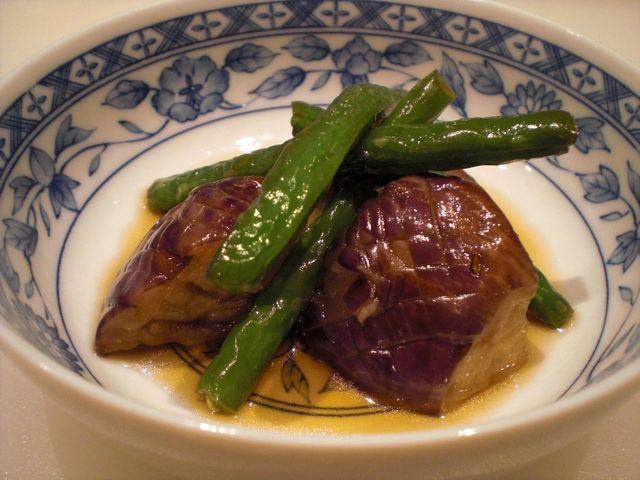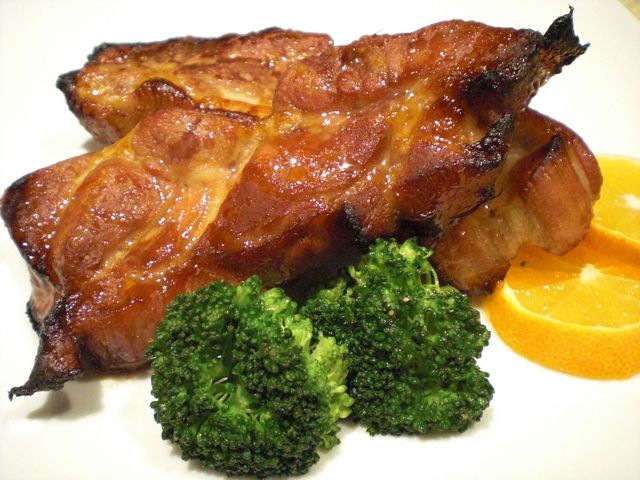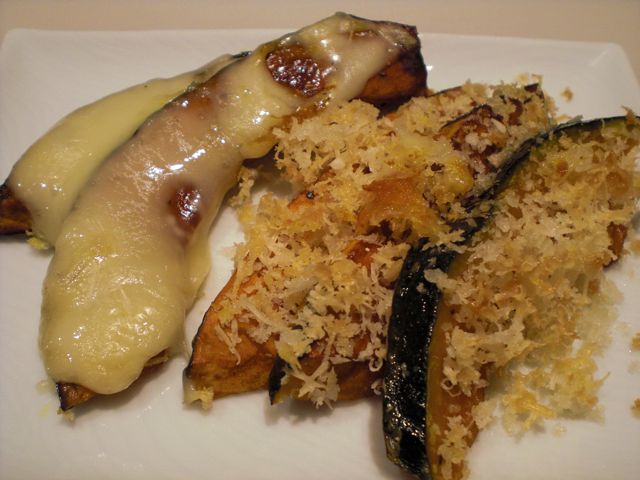Clean the pan and add a tsp of peanut oil with a dash of dark sesame oil on high heat. When the oil is almost smoking add about one cup of thawed frozen rice (leftover rice works much better since the grains separate easily) and stir until the rice is coated with oil and the grains are separated (2-3 minutes). Lightly (be aware of an additive effect of seasoning) season with salt and pepper. Add the meat/vegetable mixture back into the pan and keep stirring and flipping until well mixed. At the end, pour a small amount (about 1 tsp) of soy sauce on the inner edge of the hot frying pan so that the soy sauce gets fragrant before reaching the rice, stir or flip to mix well, and plate the fried rice. I prefer to make scrambled eggs separately. Garnish the fried rice with scrambled eggs, thinly sliced vinegared ginger root, "aonori" sea weed, and the garlic chips.
Monday, December 21, 2009
Fried rice 炒飯
This is another popular Sino-Japanese dish and perfect for ending your Izakaya feast. Like fried noodle "yakisoba"焼きそば, I make this dish with leftovers such as frozen rice and whatever vegetables and/or proteins are available. There is no real recipes per-se and there are as many variations as numbers of people who cook this dish. We are not fried rice aficionados, but, I know that some people are really into this dish and many "secrets" have been discussed. Some people appear to like having the rice grains separated and suggest mixing a beaten egg into cold cooked rice before frying. I tried this method but I do not particularly like the end result. I only make sure that the rice does not get too greasy (through judicial use of oil and cooking on very hot wok or frying pan) and is well seasoned (I add a small amount of soy sauce along the perimeter of the hot pan at the end).
 The night I made this dish, as a protein, I used thinly sliced pork spare ribs which were briefly (10 minutes) marinated in 2 parts soy sauce, 1 part sake and 1 part mirin with 1/4 tsp of grated ginger root. The vegetables I used were fresh shiitake mushrooms (4-5 medium, sliced), snow peas (10-15 pods), finely chopped onion (1/2 medium), and thinly sliced garlic (1 fat clove). I put 2 tsp of peanut oil in a non-stick frying pan and fried the garlic slices on low-medium heat until the garlic slices brown slightly (do not burn, it will get bitter). Take them out leaving garlic infused oil in the pan and set aside the garlic chips (I use them later as a garnish). I increased the heat, added onion, meat (strained of the marinade) and stir fried until the meat was cooked. I added shiitake mushrooms and snow peas, sauted until they were cooked (about 2 minutes). Season with salt and pepper and remove from the pan and set aside.
The night I made this dish, as a protein, I used thinly sliced pork spare ribs which were briefly (10 minutes) marinated in 2 parts soy sauce, 1 part sake and 1 part mirin with 1/4 tsp of grated ginger root. The vegetables I used were fresh shiitake mushrooms (4-5 medium, sliced), snow peas (10-15 pods), finely chopped onion (1/2 medium), and thinly sliced garlic (1 fat clove). I put 2 tsp of peanut oil in a non-stick frying pan and fried the garlic slices on low-medium heat until the garlic slices brown slightly (do not burn, it will get bitter). Take them out leaving garlic infused oil in the pan and set aside the garlic chips (I use them later as a garnish). I increased the heat, added onion, meat (strained of the marinade) and stir fried until the meat was cooked. I added shiitake mushrooms and snow peas, sauted until they were cooked (about 2 minutes). Season with salt and pepper and remove from the pan and set aside.
Saturday, December 19, 2009
Spaghetti casserole with goat cheese スパゲッティキャセロール
I cut the spaghetti into short pieces so that it was easier to eat and mixed with the marinara sauce. I mixed in crumbled goat cheese. On the bottom of a ramekin or small gratin dish, I added a small amount of olive oil to coat the bottom. I added the spaghetti mixture, placed two to three slices of fresh mozzarella cheese on the top and baked in a 450 degree F toaster oven for 10 minutes. I grated Parmigiano-Reggiano cheese, sprinkled with salt and cracked black pepper, drizzled a good quality EVOO (extra-virgin olive oil), garnished with of fresh basel. With Mollydooker cab, this was not bad. Although my wife still said, "I am not crazy about the spaghetti pasta". Oh, well.
Thursday, December 17, 2009
Warm Tofu with Pork-Miso sauce 肉味噌豆腐
Sweet miso sauce with added meat is rather common Japanese sauce. Mark's book has a recipe of simmered daikon ("Furofuki" daikon ふろふき大根) with pork miso sauce (p20), althouhg more traditional "furofuki" daikon (which I posted before) is with just citrus-miso sauce. This time I had a good silken tofu from Kyou-zen-an 京禅庵, I decided make this tofu dish.
First, to warm up the tofu, I made a kelp broth (1x2 rectangle of dried kelp in 3 cups of cold water, when it comes to a simmer, I added 2-3 tbs of sake, 1 tsp of salt and just a drop of soy sauce not to color the broth. Although the kelp is necessary, you do not need any seasoning. (This is just to warm tofu). Place cubes (about 2x2 inches) of tofu in the broth and simmer to warm (5-10 minutes). Do not boil.
First, to warm up the tofu, I made a kelp broth (1x2 rectangle of dried kelp in 3 cups of cold water, when it comes to a simmer, I added 2-3 tbs of sake, 1 tsp of salt and just a drop of soy sauce not to color the broth. Although the kelp is necessary, you do not need any seasoning. (This is just to warm tofu). Place cubes (about 2x2 inches) of tofu in the broth and simmer to warm (5-10 minutes). Do not boil.
To make the pork-miso sauce, first saute finely chopped scallion (2 tbs), ginger (1/2 tsp), garlic (one small clove) in 1-2 tsp of vegetable oil. When these are soft and fragrant, add ground or hand-chopped pork (about 4 tbs), stir until the pork is cooked. Add 2 tsp of red miso, 2 tbs of mirin (I did not use sugar). Stir until nice saucy consistency is reached. If it is too thick, add the kelp broth to loosen the sauce. If you prefer the sauce to be bit sweeter add sugar.
Place warm tofu in a bowl, pour over the pork-miso sauce. Garnish with lime zests (I used a micrograter) and a wedge of lime. Squeeze lime juice and enjoy (for silken tofu, even if you are a chopstick jedi, you definitely need a spoon).
Monday, December 14, 2009
Deep fried egg plant in broth なすの揚げ浸し
Deep fried eggplant in Dashi Marinade なすの揚げ浸し
(Based on the recipe in Mark's book p64)

This is one of the classic Japanese dishes--"Age-bitashi" 揚げ浸し meaning "fried and soaked". It is a very common Japanese cooking technique in which the ingredient is first deep fried and, while it is hot, soaked in a seasoned broth (aside from the usual soy sauce flavor, sometimes with added vinegar and/or hot pepper). Mark's book has this dish (p64), I only substituted green beans for the small Japanese green peppers "shishito" since I did not have "shishito". In the U.S., the types of eggplant "nasubi" 茄子 available are quite different from those in Japan. So called American eggplant "bei-nasu" 米茄子 is good for baked dishes such as eggplant parmesan or moussaka but not for this dish. I use a smaller eggplant with a thiner skin. Chinese or Japanese (elongated light or dark purple), or small Italian eggplants work best.
This is one of the classic Japanese dishes--"Age-bitashi" 揚げ浸し meaning "fried and soaked". It is a very common Japanese cooking technique in which the ingredient is first deep fried and, while it is hot, soaked in a seasoned broth (aside from the usual soy sauce flavor, sometimes with added vinegar and/or hot pepper). Mark's book has this dish (p64), I only substituted green beans for the small Japanese green peppers "shishito" since I did not have "shishito". In the U.S., the types of eggplant "nasubi" 茄子 available are quite different from those in Japan. So called American eggplant "bei-nasu" 米茄子 is good for baked dishes such as eggplant parmesan or moussaka but not for this dish. I use a smaller eggplant with a thiner skin. Chinese or Japanese (elongated light or dark purple), or small Italian eggplants work best.
Here I used a medium-sized light purple striped eggplant called "graffiti" eggplant. In any case, I cut the eggplant into 1x1 inch size pieces and then made shallow criss-crossing scores on the skin (hatch marks). This makes the skin more palatable and allows the broth to soak in better. I sprinkled the pieces with a small amount of salt and placed them in a colander for 15 minute. I then wiped the surface with paper towels to remove the salt and moisture. Meanwhile, I trimmed both ends of the green beans (10-15 or whatever amount) and wiped the surface dry with a paper towel.
I made the broth from a commercial concentrated noodle broth in a bottle but, of course, you could make this from scratch according to the recipe in Mark's book. I diluted the concentrate to taste (slightly stronger than that for broth for noodles, i.e., for the x2 concentrate, I diluted to x1.5) with cold water and then warmed it up and set aside in a flat sealable container.
I heated the peanut oil in a pan to about 340F (170C). I made sure both green beans and eggplant were dry (using paper towels) to prevent spattering when they were put into the hot oil. I fried the green beans first for 1 minute and put them on a paper towel to drain and the put them in the broth. Next, I fried the eggplant. Skin side down first then turned them over several times for 4-5 minutes until the meat of the eggplant becomes slightly brown and cooked through. I drained the eggplant on a paper towel and placed them in a colander. I poured hot water over them to remove excess oil. Then, I put the eggplant in the broth with the green beans. I let it cool down to room temperature and then put into the refrigerator. It is best to leave it for at least 30 minutes or overnight before serving.
This dish has subtle flavors but the eggplant is very rich and has a nice soft texture. This is a very nice dish with sake.
Saturday, December 12, 2009
Pork spare ribs baked in barbecue sauce ポークスペアリブ バーベキューソース
This is a good ol' American version of pork spare ribs. Instead of marinating in soy flavored marinade and baking as was done in the "soy-flavoured spare ribs" or Japanese style spare ribs 和風スペアリブ (Mark's book p92), this one is baked in a sweet and sour, ketchup based sauce. Cooking in liquid makes the meat much more tender as opposed to dry baking. We sort of like this version better and, as we served it, it can definitely pass as Izakaya food.
This dish was made by my wife, I only helped by chopping up onions and holding the oven door. It is based on a recipe in the American Classic "Joy of Cooking." We used 4 good sized bone-in pork spare ribs. For the sauce; A piece of bacon (half strip) was cooked to crisp and set aside. Two medium onions were coarsely diced and sauteed in a small amount of the bacon drippings until soft and caramerized (15-20 minutes). One cup of ketchup was added to the pan and cooked, scraping the bits left behind from cooking the bacon and onions, until the sugar in the ketchup was caramelized (the color will change from red to more dull brownish color). We learned this trick from Graham Kerr, the Galloping Gourmet. Combine, the onion, the slice of bacon crumbled and the ketchup in a sauce pan with a mixture of rice vinegar (2 tbs), water (1/2 cup), lemon (1/4 cup), paprika powder (1/2 tsp), Worcestershire sauce ( 1 tbs), salt (1 tsp), brown sugar (1 tbs) and mustard (1 tbs.) and simmer for about 15 minutes. Meanwhile parboil the spareribs for about 5 minutes in a seperate saucepan. Remove the parboiled spare ribs from the hot water and put them in an oven safe baking dish so they fit snugly. Pour the sauce over the ribs to cover. Loosely cover the dish with aluminum foil (do not seal). Place it in a 450F oven for 15 minutes. Remove the aluminum foil and reduce the temperature to 350 F and continue cooking for 1 hour or longer until the meat becomes very tender and the surface browns. I suppose this colud easily be adapted to be cooked in a slow cooker as well.
This has a classic sweet and sour flavor which goes well with pork. For libation, sake and beer will go well. Even red wines such as Australian Shiraz or Argentinean Malbec will be a good match. We had Ave Malbec Premium 2007 from Argentina with this and was wonderful.
Thursday, December 10, 2009
Soy-flavoured Spare Ribs 和風スペアリブ
Soy-flavoured Spare Ribs 和風スペアリブ (Mark's book p92)
 This is from Mark's book p92. Again, this is not a quite traditional Izakaya fare but this is a type of dish that goes perfectly well with sake or beer or even wine. I followed the recipe fairly closely but the marinade is sort of standard. Remove bones from pork spare ribs and also remove fat if too much fat is attached. The marinade consists 2 tbs each of sake and mirin and 3 tbs of soy sauce with grated ginger root (1/2 tbs) and pressed or finely chopped garlic (one clove). (The recipe in Mark's book also adds 1/4 sliced onion and dark sesame oil). Marinate the meat in a zip-lock bag for at least 6 hours or overnight (I did overnight). Place the meat in the baking pan with a grate and bake it in a 350F oven for a total of 30 minutes.
This is from Mark's book p92. Again, this is not a quite traditional Izakaya fare but this is a type of dish that goes perfectly well with sake or beer or even wine. I followed the recipe fairly closely but the marinade is sort of standard. Remove bones from pork spare ribs and also remove fat if too much fat is attached. The marinade consists 2 tbs each of sake and mirin and 3 tbs of soy sauce with grated ginger root (1/2 tbs) and pressed or finely chopped garlic (one clove). (The recipe in Mark's book also adds 1/4 sliced onion and dark sesame oil). Marinate the meat in a zip-lock bag for at least 6 hours or overnight (I did overnight). Place the meat in the baking pan with a grate and bake it in a 350F oven for a total of 30 minutes.
It is not bad but we are not sure if this is the best way to cook pork spare ribs. It has nice sweet, soy sauce and ginger flavors; however, although there is good amount of fat, the meat is a bit dry and the fat appears not to be adequately rendered. We sort of like American ways of cooking such as long baking in a liquid/sauce or more traditional barbecue. We may post the way my wife cooks pork spare ribs in the near future. In any case, we enjoyed this with California Bordeaux blend, Burgess Cellars "Ilona" Howell Mountain Red 2003. Rich pork tastes went very well with this wine.
Tuesday, December 8, 2009
Kabocha hors d'oeuvres three ways カボチャのオードブル三種類
I found a rather good looking Japanese winter squash "kobocha" being sold as a "butter cup" squash in a near-by grocery store. I do not think this is a "butter cup" squash since the "cup" on the blossom end is not present but I do think this is a Japanse "Kabocha". In any case, I could not resist buying one. So I ended up with a rather large amount of kabocha. After I made my usual simmered kabocha かぼちゃの煮物 and pottage かぼちゃのポタージュ, I still had at least 1/3 of the kabocha left. I thought about making kabocha tempra etc but settled on these three quick dishes.
Kabocha and oninon with red miso sauce かぼちゃとタマネギのしぎ焼き
Broiled Kabocha with Raclette cheese かぼちゃとラクレットチーズ
Broiled Kabocha with Parmegian cheese and panko かぼちゃとパルメザンチーズ

These are also a spur-of-the-moment type dish. I cut the kabocha into slices 1/4 to 1/3 inch thick, 2-3 inch wide and sauteed them similarly to the previous dish until soft. (I suppose one can do this step in a microwave oven.) It needed to cook a bit longer than the "shigi-yaki" dish since the pieces were thicker. (I did this when I made the first dish) and set aside on a paper towel lined plate. Just before serving, I put these kabocha pieces on a cookie sheet (small one which fits into my toaster oven); Some were topped with slices of raclette cheese (left two) and others (right three) were topped with a mixture of panko (mixed with bit of good oilve oil) and grated Parmigiano-Reggiano cheese (about half and half) and baked in the 450F toaster oven for few minutes until the raclette cheese melts and Panko-Parmesian becomes golden brown.
Subscribe to:
Comments (Atom)


